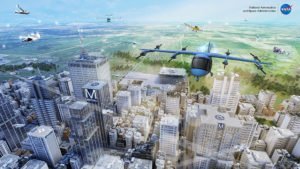What is a vertiport, exactly, and how should vertiport technology be integrated into the current transportation infrastructure? More than 70 representatives from the FAA, NASA, and industry gathered earlier this month to “further develop a strategic plan that supports NASA’s advanced air mobility (AAM) efforts,” says a NUAIR press release. “NASA awarded Oneida County this critical contract in August 2020 to conduct research in automation technology to support high-density vertiport operations that facilitate the vertical takeoff and landing of large-scale unmanned aircraft across populated areas.”
NUAIR manages a project team that includes Deloitte, Boeing, Crown Consulting, Mosaic ATM, 5-Alpha LLC, Helicopter Association International (HAI) and the General Aircraft Manufacturers Association (GAMA). The team has worked together for 8 months, developing 3 reports: a trade study, the concept of operations (ConOps), and the software architecture requirements for vertiport automation. At the March meeting, the project team brought in a wide audience of industry stakeholders to review the reports and discuss next steps.
What is a Vertiport? The Required Infrastructure for Passenger Drones
NUAIR explains exactly what a vertiport is: “A vertiport is a collective term referring to areas designed specifically for AAM aircraft to take off and land, much like a heliport is a designated area for helicopters. Dr. Marcus Johnson, high-density vertiplex subproject manager, NASA, opened the event by discussing NASA’s overall vertiport research plans, which all stem from the groundwork being developed in this initial project,” says the press release. “Robert Bassey of the FAA gave an update on vertiport standards development and research, outlining multiple operational requirements for vertiport facilities including layout designs, electrical needs, and safety requirements. The FAA and NASA meet regularly with the AAM industry for open collaboration in building the future of public air transportation.”
Vertiport Design Concepts
Michael Patterson, systems analysis and AAM ConOps lead, NASA, reported on the current maturity level of AAM and gave an in-depth vision of what is needed and what it might look like to advance into the “intermediate” maturity level. This level would consist of complex operations and automated systems, consisting of hundreds of simultaneous flights. Individual aircraft may have the option of being flown by an onboard pilot, flown using simplified vehicle operations or by someone at a “command station” who may be piloting or monitoring multiple aircraft at once.
Vertiports could be built on top of buildings, be a hub like an airport, or says the press release, they could be designed with a bus stop concept: a simple “Vertistop” would be just for drop-offs and pickups. “Air traffic will be a mix of piloted, semi-automated, and fully automated aircraft with multiple vertiport configurations depending on the location and type of operation.”
“We had a great turnout, with solid support from NASA and the FAA. The interaction and back-and-forth between speakers and participants was amazing,” said Jonathan Daniels, NUAIR’s chief of strategy, Vertiport Project Lead and event host. “It’s always important to break out of your perceptual bubble and get some outside feedback from the industry stakeholders that will be a part of this new innovative system.”
Miriam McNabb is the Editor-in-Chief of DRONELIFE and CEO of JobForDrones, a professional drone services marketplace, and a fascinated observer of the emerging drone industry and the regulatory environment for drones. Miriam has penned over 3,000 articles focused on the commercial drone space and is an international speaker and recognized figure in the industry. Miriam has a degree from the University of Chicago and over 20 years of experience in high tech sales and marketing for new technologies.
For drone industry consulting or writing, Email Miriam.
TWITTER:@spaldingbarker
Subscribe to DroneLife here.
https://dronelife.com/2021/03/28/what-is-a-vertiport-nuair-brings-industry-players-together-to-develop-advanced-air-mobility-strategies/
